
Pg 142
treasurer of the township. The law also provided for the people of each school district to meet on the first Saturday in May and vote for or against a tax for school purposes. As many of the early settlers came from states where "free school" had never been established and where prejudice against free schools was intense, the early so-called free schools were a farce.
The prejudice and whims of the people must be overcome and the law must be made obligatory before the real free school could exist. In February, 1857, the legislature of Illinois passed a new act to establish and maintain free schools, which provided for the election of a state superintendent of schools, for the election of county school commissioners and making it obligatory on the part of the officers to enforce the law.
The constitution of 1870 created the office of State Superintendent of Public Instruction and defined the duties of the

Pg 143
officer. The office of County Superintendent of Schools was also created and his duties defined.
With the school laws of 1857 and the constitution of 1870 creating office of State Superintendent of Schools and County Superintendent of Schools, the school system of Illinois has become very efficient.
From three or four communities maintaining schools the county system of schools has grown till now the county has 107 school districts, including three high schools and one non-high school district.
The school population of 1818 probably was not more than 500, the school population in 1918 is more than 25,000.
The first school houses were built of logs or poles with stick and clay chimney. The house was covered with clapboard, held on by laying on heavy poles. The huge fireplace usually took most of one end of the house. The teacher and children gathered the wood from the surrounding forest.
The first frame county schoolhouse was called the Frame just east of Parrish. Contrast this condition with our present condition. Modern schoolhouses well lighted, ventilated, heated, seated and with all the appliances that a teacher could wish.
The county now has splendid school buildings. The old log house has long since disappeared and has been replaced by the modern brick or frame. The school buildings at Benton, Frankfort, Thompsonville, Logan, Zeigler, Christopher, and Sesser can not be excelled anywhere in the state or nation.
The legislature of 1841, incorporated the Benton Academy with Walter S. Aiken, John Ewing, John P. Maddox, Zack Sullens, Thomas Thompson, John Edgerly, Benj. Smith, Abraham Rea, Wm. Browning, Silas M. Williams, Moses Neal, John Dillon and Lemuel Harrison as trustees.
The trustees purchased a lot and put up a two-story frame building. This was the first graded or high school in the county. The new academy was a failure and the trustees sold the property to the Benton School District. In 1868 the first
Pg 144
brick school building in the county was erected on this lot, and in later years was known as the Logan School building. This building was torn down in 1917 and a building erected on the south part of this lot.
About 1841 the legislature created the "Fancy Farm" College, about two miles from the Old Jordan Fort, Alex McCreery, Henry Yost, Sion Mitchell, Richard Cantrell and
Wm. Jones were named as the trustees.
The object of the school was to promote science and literature. The college did not flourish however. Nothing now remains of it but the "Fancy Farm."
In this same locality there was a graded school for many years, which had a telling influence on the community.
In 1864, Dr. John Washburn, a refugee from Tennessee on account of his union sentiments, landed in Marion, Ill., then proceeded to Crawford's Prairie on the north where he opened a school. His fame as a teacher spread. Then for three years he was principal of the Benton High School. In 1867, he

Pg 145
began a select school at Frizzell Prairie Baptist Church. During the time of this select school the citizens organized the Ewing High School. In 1874, the Ewing High School was merged into Ewing College. Dr. Washburn was president of the college except about four years, until about 1891 when Dr. J. A. Leavitt became president and continued so for many years. Since then, Prof. Arthur Summers has been president.
The college has flourished and has been a "Beacon light throughout all Egypt" and even extending its bright light far beyond the limits of Egypt.
Dr. Washburn has gone from us. He is buried in another county, at McLeansboro, but he lives on in the hearts of his friends in Franklin County. His precepts, and noble manhood will live on in the hearts of the people, and will need no "Marker" to point out where he stood.
The history of Ewing College would not be complete without mentioning some of the citizens who worked with Dr. Washburn in establishing the college.
Hon. R. R. Link was an untiring worker and was the secretary as long as he lived.
He was the magnet who drew students to the college. Many a poor boy has been given encouragement and hope by the solicitations of Mr. Link.
Those citizens of the vicinity of Ewing who gave their money and put their whole soul into it to make it a success are:
Wm. A. King, E. T. and John S. Webb, R. Richeson, John W. Hill and R. R. Link. These men put the burden of establishing the college upon their shoulders and heroically carried the institution until it could stand upon its own base.
The college has been a great factor in the educational development of Franklin County. The college has been the leaven in the bread. It has been the means of bringing the people to a higher plane of living. In the shadows of the closing century of Franklin County's history, all take pride in saying Ewing College has been a large factor in its development.
Pg 146
The following school superintendents have served Franklin County since 1849:
Sion Mitchell 1849-1854
Lewis C. Payne 1849-1854
Peter Phillips 1858-1861
John Ward 1861-1865
R. R. Link 1865-1873
G. C. Ross 1873-1874
H. A. Doty 1874-1877
C. D. Threlkeld 1877-1881
Elijah Rotramel 1881-1882
C. D. Threlkeld 1882-1890
W. F. Dillon 1890-1894
H. M. Aiken 1894-1898
W. S. Buntin 1898-1902
H. M. Aiken 1902-1906
Offa Neal 1906-1910
C. W. Mundell 1910-1914
H. Clay Ing. 1914-1918
Pg 147
The history of Franklin County written in 1886 has the following to say about coal in the county: "The coal of Franklin County is of little value, the seams being uniformly too thin for working, and there is no out crop of stratified rocks in any of the deep gulleys that furrow the sides of the Frankfort Hill. Coal No. 7 is believed to underlie the county at a depth averaging from about 150 feet in the northern and western portions to about 500 feet in the central and southern portions, too deep for profitable investment in mining operations at present."
From the above we would infer that if the coal investors and operators had been guided by this information nothing in the way of coal investments would have been made in Franklin County.
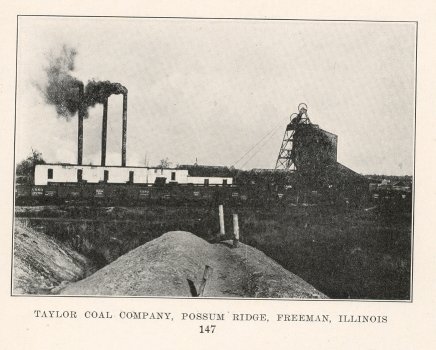
Pg 148
I quote from the statement of a man who has a great deal of experience as a promoter and coal operator in Franklin County. "The most important element in the prosperity of Franklin County, has been and will continue to be the development of its coal fields.
"Practically the entire area of the county is underlaid with a deposit of coal of unusual quality. There are several veins of this coal, the most important of which is the No. 6 seam, now being worked at various points in the county, which vein lies at a depth of about 350 feet at the county line, increasing in depth at the rate of about 25 feet per mile following the dip towards the northeast. This vein has an average thickness of practically 9 feet.
"Below this No. 6 vein running from 4 1/2 to 5 feet in average thickness, which up to the present time, has not hardly been taken into account, on account of the superior thickness of the overlying No. 6 seam; but long before the No. 6 seam has been worked out, the lower or No. 5 seam will have attracted much
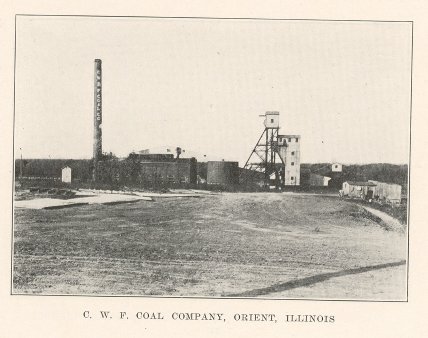
Pg 149
attention and will be of great value on account of its quality and workable thickness. These two seams guarantee the permanence and importance of the coal industry for the next 100 years.
These statements do not agree, but we will be compelled to agree with the latter statement. The latter statement comes from a man who has had years of experience in prospecting, sinking shafts, and operating mines in different parts of the county. The statement that the two seams of Franklin County coal "guarantee the permanence and importance of the coal industry for the next 100 years" means a great deal to the county as a factor in its coal industry and all industries where coal is used.
The citizens of Benton prospected for artesian water to the depth of about 500 feet and failed to find any coal of much value. It was then generally accepted that there was no coal in this county.
Later, prospecting was done by W. P. Holliday, of Cairo,

Pg 150
who prospected for coal in Six Mile Township. He discovered a fine vein of coal but kept it as a secret until his death. It was reported that he intended to buy a large tract of land in Six Mile Township.
The next prospecting was done by the citizens of West Frankfort which discovered and proclaimed to the public the real Eldorado of Franklin County.
Joseph Leiter purchased 8,000 acres of coal land in Six Mile and Denning Townships in 1901 and developed one of the largest and best equipped mines in the state at that time. The seam on his tract averaged about 11 feet thick and of a superior quality of coal. This discovery of the county's wonderful resource caused a great demand for coal lands in the county.
Mr. Leiter saw the great value of this coal, and by careful advertising introduced his coal into the general market.
As the quality of this coal became generally known there was a general movement among coal men and transportation
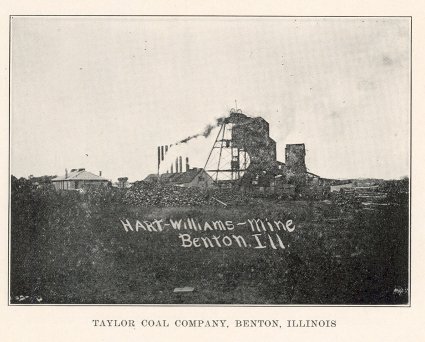
Pg 151
lines to acquire holdings in this county. As a result of this movement there are 23 coal mines in the county and many miles of railroad have been built into the county.
Today, Franklin County produces more coal than any county in the state or United States. The annual production with all mines running is about $60,000,000 of coal. There is more than $1,200,000 paid out for labor each month in the year in this county.
The coal production in the county has caused the county to increase rapidly in population. In 1900 the population was about 20,000 people, now, it will approximate 60,000 people, three times its former population.
Franklin County must give the credit to Joseph Leiter for discovering its great resources and advertising the quality of its coal. Mr. Leiter built an industrial town and called it Zeigler for his father's middle name.
This town grew rapidly at first but serious labor trouble came up and, followed by an awful explosion in which many miners lost their lives, retarded its progress. The mining business at this point did not thrive so well for a while. Bell & Zoller took hold of the mine and it has been very successful
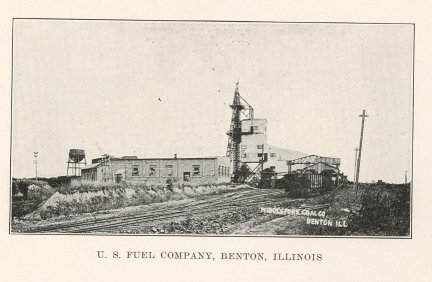
Pg 152
since. They are sinking another mine south of the first mine which will doubtless be the largest mine in the state. The city of Zeigler is growing rapidly and will soon take her place among the fast growing cities of "Egypt."
While much credit is due Mr. Leiter for the discovery of the county's immense wealth, yet we must not forget the home people, who began developing our vast resources. The county must take off her hat to W. H. Hart and Walter W. Williams for their efforts in developing the coal industry at Benton and West Frankfort. They sank the shaft of the Deering Mine No. 11 then sold it and began developing at Benton. They organized the Benton Coal Company and this company developed the first mine at Benton. Later Hart & Williams sold out their interest and began developing the Hart-Williams Mine east of the Benton Coal Company.
A company of Benton people organized the Middle Fork Mining Co. and sank a shaft two miles east of Benton. This mine was sold to the U. S. Fuel Co., which has been improved
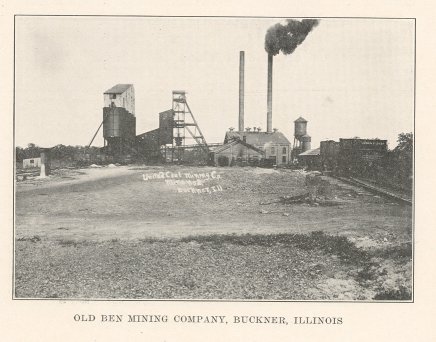
Pg 153
greatly. The Bunsen Coal Co. own more than 50,000 acres of coal land in the east part of the county, adjacent to this mine.
The Franklin County Coal Co. have developed a mine north east of Benton, though not of the largest size, the mine is being well equipped with modern improvements.
The Old Ben Corporation of Frankfort, Christopher and Buckner, is one of the greatest organizations for producing coal in the county. They have a mine in the south part of West Frankfort and one east of Frankfort Heights. Then at Christopher and Buckner they have four large mines in their organization. The Old Ben Coal is well known in the north and northwest. The Old Ben Coal Corporation is now sinking a shaft southwest of Frankfort. The name of the new town where the new mine is located is Pershing.
W. P. Rend & Co. is the name of a coal company located west of Benton about five miles. They operate another mine just over the line in Williamson County.

Pg 154
The big coal companies operating in Franklin County are the Old Ben Corporation, the Bell & Zoller, Chicago, Wilmington and Franklin Coal Co., John A. Logan Coal Co., Franklin Coal and Coke Co., and T. C. Keller Coal Co.
Pg 155
On January 2, 1818, the Legislative Council and House of Representatives of the Illinois Territory passed an act creating the county of Franklin. In that act it was provided that until a permanent seat of Justice was established for said county and public buildings erected, all court should be held at the house of Moses Garret which was situated about 3 miles east of Old Frankfort.
In the year 1821 the town of Frankfort was located and platted and soon thereafter public buildings were erected. Owing to the fact that on November 18, 1843 the office of the circuit clerk of Franklin County was destroyed by fire, it is difficult to ascertain the exact date of the first court held in Franklin County. However, about the year 1822 circuit court convened at Frankfort, the presiding judge being Samuel D. Lockwood, a member of the Supreme Court. At that time our Supreme Court was composed of five judges who, after performing their duties on the Supreme Bench would separate and hold the several circuit courts of the state which were then but few in number. Up to the time of the removal of the county seat to Benton in the year 1841, supreme judges, Lockwood, Browne, Hardin, and Scates, presided over our circuit court.
In those days it was the custom of the lawyers to "ride the circuit" with the presiding judge. Old Frankfort was the scene of many a distinguished gathering. From Shawneetown on the east, Kaskaskia on the west, Cairo on the south and even as far north as Springfield, the lawyers would come to attend court.
Pg 156
At this day the lawyers of Franklin county are prone to grumble at the poor accommodations we have by reason of the insufficiency of our court house. A perusal of the early records of our county will show that in the "good old days" accommodations were not nearly so good as at the present time. At the September Term, 1837, the grand jury in its report to the judge has this to say relative to the condition of the court house and clerk's office at Old Frankfort:
"We, the Grand Jury, of the county of Franklin of the September Term of the circuit court thereof respectfully represent that they have had occasion to examine the public buildings of said county situate in the town of Frankfort, erected for the transaction of the public business and affairs of our county and in noting them we cannot but express our regret at the total unfitness of the court house and clerk's office for the uses designed. The clerk's office has been built about fifteen years and was of flimsy workmanship at best and is now from age anything but a fit building for the safe depository of the records of the county or an ornament to the county. The court house is of brick of mean dimensions, poor construction and badly finished; and it is now in a dilapidated state - both gable ends blown down and unfit for the change of the weather. The county of Perry has erected a good court house. Jefferson is about undertaking the same. Jackson long has had a tolerable one but unfinished. Pope, Gallatin and White with comparatively but little greater means have erected good court houses that are convenient buildings for the transaction of all public business. The reputation of this country is rapidly increasing as well as its taxable property and also the business of the country is rapidly increasing and requires more than its present conveniences for its transaction. The grand jury recommends to the County Commissioners Court the propriety and necessity of contracting for the immediate construction of a court house for the county of Franklin with office room for the public offices of the county."
Pg 157
The first lawyer who was a permanent resident of Franklin county was an Englishman, named Richard Nelson, a native of the Isle of Man. Nelson, prior to the year 1830, when a very young man, came to the house of S. M. Hubbard, who was then the clerk of the circuit court at Frankfort, riding on a poor old horse which the Hubbards appropriately named "Bones." He lived with Mr. Hubbard for several years assisting him in his clerical duties and soon after coming to Frankfort began the practice of law. He was a diligent student and was said to be, when in his prime, the best Chancery lawyer and judge of law in Southern Illinois. He was tall, spare and commanding in appearance. His practice was extensive, extending throughout the southern part of our state. He died at Metropolis, many years ago.
Wm. A. Denning was the first native of Franklin county who was admitted to the bar. He was born in Townmount Prairie and began the practice of law in 1830. He was judge of our circuit court for a period of about seven years and was chosen by the General Assembly of Illinois as a judge of the Supreme Court, filling the vacancy occasioned by the resignation of Justice Walter B. Scates.
Judge Denning's commission as a Supreme Judge bears date of January 19, 1847. His portrait now occupies a prominent position in our new Supreme Court building at Springfield.
After the removal of the county seat from Old Frankfort the first circuit court ever held in Benton convened on Monday, April 19, 1841, Judge Wm. A. Denning, presiding. It was held in a small frame building and it may be of interest to note that the first court house and clerk's office in Benton together cost the large sum of $539.50.
In those days the quarters provided for the inmates of our jail were not very luxurious. At the March term 1846, of our circuit court the grand jury reported on the condition of our jail as follows:
Pg 158
"The grand jury have examined the jail as the law directs and report that they find the locks of said jail very insufficient and are of the opinion that the prisoners should be furnished with chairs or some kind of seats to sit on. The jury would report that they find the jail as clean as could be expected under the circumstances and the treatment of the prisoners is as good as their situation will admit of. The jury would suggest the propriety of keeping the upper part of the jail swept clean in as much as the prisoners complain that the dirt and dust fall in their eyes.
The jury would further suggest that they are of the opinion that some kind of a coarse bedding should be provided for the prisoners. That at the present they are only furnished with straw to lie on at that laying loosely on the floor of the jail.
All of which is respectfully submitted.
JOHN EWING, Foreman."
Franklin County has furnished six circuit judges, namely:
Wm. A. Denning, Wm. K. Parrish, Andrew D. Duff, Monroe C. Crawford, Daniel M. Browning and Charles H. Miller, who have presided with dignity and credit.
Special mention should be made of Judge Andrew D. Duff, who was the first county judge of Franklin county after our county court was established by the constitution of 1848 and who was circuit judge from 1861 to 1875. Judge Duff was a soldier in the Mexican War. He had few, if any early advantages, but was a great student. During the time that he was circuit judge he maintained a law school in Benton that was attended by young men from the various parts of Southern Illinois. His students have risen to eminence as lawyers.
General John A. Logan was a resident of Benton from 1854 to 1857, during which time he was prosecuting attorney. While he was a resident of Benton he married his wife at Shawneetown. One of our old residents, Mrs. Tabitha Browning, tells in a most interesting manner of how she aided in
Pg 159
preparing the wedding or "infare" dinner for General Logan and his bride.
At the present time our circuit court is almost continuously in session. The city courts of West Frankfort and Benton transact a great deal of business. The scenes are much different from the time when nearly one hundred years ago Judge Lockwood convened the first court in Franklin County. The lawyers are supplied with extensive libraries, typewriters, telephone and all other conveniences to aid them in expediting their work. However, we are indebted beyond measure to these hardy pioneers among the lawyers and judges who rode the circuit, tried their cases with but few law books or precedents, wrote their pleadings with goose quill pens and suffered the many inconveniences of their day. They were the leaders in moulding public opinion; they taught respect for the law, and the results of their labors but emphasize the truth of the old maxim that: "The certainty of the law is the mother of repose."